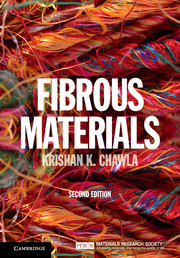Book contents
- Frontmatter
- Dedication
- Contents
- Preface to the Second Edition
- Preface to the First Edition
- Acknowledgments
- 1 Introduction
- 2 Fibers and fibrous products
- 3 Natural polymeric fibers
- 4 Synthetic polymeric fibers
- 5 Electrospun fibers
- 6 Metallic fibers
- 7 Ceramic fibers
- 8 Glass fibers
- 9 Carbon fibers
- 10 Experimental determination of fiber properties
- 11 Statistical treatment of fiber strength
- Appendix: Some important units and conversion factors
- Indexes
- Plate section
Preface to the Second Edition
Published online by Cambridge University Press: 05 June 2016
- Frontmatter
- Dedication
- Contents
- Preface to the Second Edition
- Preface to the First Edition
- Acknowledgments
- 1 Introduction
- 2 Fibers and fibrous products
- 3 Natural polymeric fibers
- 4 Synthetic polymeric fibers
- 5 Electrospun fibers
- 6 Metallic fibers
- 7 Ceramic fibers
- 8 Glass fibers
- 9 Carbon fibers
- 10 Experimental determination of fiber properties
- 11 Statistical treatment of fiber strength
- Appendix: Some important units and conversion factors
- Indexes
- Plate section
Summary
Fibrous materials are ubiquitous. Nature makes extensive use of the fibrous form of matter because fibers are extremely flexible, allowing for complex shapes to be formed. Fibers can be natural (cotton, jute, etc.) or synthetic (polyamide, polyethylene, etc.). Synthetic fibers, however, form a large part of our economy. Among synthetic fibers, the so-called high performance fibers (HPF) represent a very small segment by volume. Small though this segment is, it is a very vital one. It is driven by special functions that require specific properties unique to these fibers. Usually HPFs have very high levels of at least one of the following properties: stiffness, strength, ability to resist high temperatures, optical signal transmission, and high resistance to chemicals. Since the publication of the first edition of this book, there has been tremendous progress in the field of fibrous materials. As an example, carbon fibers (one of the HPFs) have entered the era of large scale commercial use in civilian aircraft. Impressive developments in our understanding of spidersilk fiber, processing of synthetic polymeric fibers, metallic fibers and ceramic fibers are recorded in this second edition. Impressive gains have been made in making high strength, lightweight organic fibers such as aramid, polyethylene, etc. as well as very high temperature ceramic fibers such as alumina, silicon carbide, etc. Metallic fibers are used for reinforcement (think of tires), cords and ropes for elevators, bridge cables, etc. Less well known are the superconducting metallic filaments. Other applications of materials in a fibrous form include:
• clothing, garments, carpets, cables, ropes and cords;
• reinforcement of polymers, metals, ceramics, and cement for structural purposes;
• geotextiles for soil-stabilization;
• optical fibers for communication purposes, etc. All the data (audio, video, and data) transmission that we take for granted today, indeed the whole field of fiber optics, would not be possible without the availability of specialty glass fiber. As an aside, we should mention that Charles Kao was awarded the Nobel Prize in physics in 2009 for his work on fiber optics.
The basic theme of the second edition of this book continues to be the triad of processing–structure–properties of various materials in fibrous form. It is the only book that covers the whole range of fibrous materials available.
Information
- Type
- Chapter
- Information
- Fibrous Materials , pp. xi - xiiPublisher: Cambridge University PressPrint publication year: 2016
